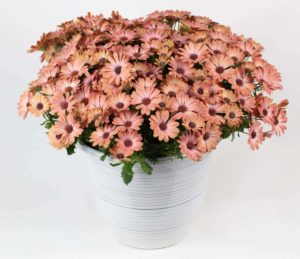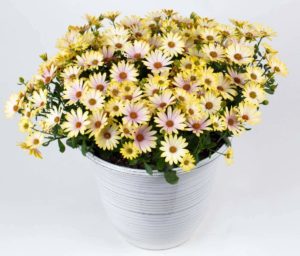
Culture Report: Osteospermum Gelato Series
Let’s be honest: Osteospermum were not quite ready for the market when they came out 20-25 years ago. They were part of the wave of revolutionary vegetative varieties that have come to define premium annual crops as we know them today. And, while at the time were a huge breakthrough, through the lens of hindsight we can see that they were not the easiest or best crops for some garden environments. Consistently performing well in trials across the United States, the osteospermum Gelato series is re-invigorating the genus as an option for growers and home gardeners everywhere.

With most of the cultivated varieties being derived from species native to Southern Africa, one of the most unique climates on Earth, some unique cultural requirements were programmed into the plants. Some of the positive attributes, gorgeous flowers and drought tolerance, were accentuated while some of the more challenging cultural preferences, cool temperatures to initiate flowering and seasonal blooming, were selected against. Fast forward to today after decades of breeding and selection work, and we have a much-improved plant product for the market: the Gelato series. Freely flowering all season long, they offer diverse flower color options on heavy branching plants with medium and compact habits that are well suited for quart pot production up to 12-inch patio pots.
The Gelato series is well suited to most climates and brings not only cold and drought tolerance, due to its heritage, but also impressive heat tolerance, which has also reduced cold temperatures needed to achieve flower initiation to an average daily temperature (ADT) of 57° F.
PROPAGATION
Propagation is straightforward, typically taking four to five weeks, depending on your growing region. Stick unrooted cuttings into clean, loose propagation media or an engineered soil plug, shortly after receiving. Grow under mist/fog at 72 to 76° F, treat with KIBA at 100 ppm and a broadspectrum fungicide, and utilize bottom heat to aid in rooting speed and uniformity.

I always recommend giving URCs just enough moisture to keep them from wilting, since excess moisture does not provide any benefit and typically causes problems. You can begin reducing heat and mist as callus, and eventually root initials, develop to begin toning plants. Light feeding (50- to 100-ppm nitrogen) regimes while roots develop will avoid excessive growth or damage due to salts accumulation. Maintaining an EC around 0.7 to 0.9 and pH around 5.8 will provide the best results. Supplemental lighting will also aid in producing a higher quality crop. A pinch four weeks after stick or one week after transplant is recommended to enhance branching and control initial growth. This could be substituted with a PGR spray, but rates and chemicals should be trialed before wide-scale adoption.
FINISHING
Keeping in mind that plants should be grown at an ADT of 58 to 64° F for best performance, there are two methods that growers can use to produce high-quality osteospermum Gelato plants for finish.
The first way is the simplest way in that plants are transplanted and then grown as a cool/cold crop with an initial ADT of 57° F or lower for at least three weeks. Plants can then grow under the naturally cool temperatures and finish five to six weeks later. The advantage is it is easy to mix these with other cooler temperature-loving crops like pansies and primula to develop naturally with the season. This method is best with small pots and for super energy-efficient production practices.

The second method needs a bit more manipulation but allows for a bit more programmability if there is a specific sales date or the finish time is earlier than typical. Transplant unpinched liners, then pinch after about one week or after roots have grown into the new soil. Continue growing the plants under around 62 to 66° F until the plants get close to finished size, ensuring that vegetative growth is not too excessive. Then drop the temperatures to or below 57° F ADT for three weeks to initiate flowering then return to warmer growing conditions to finish. Flowering should occur in five to six weeks. The only caveat is that under low-light conditions, flower development may be poor, so supplemental lighting is recommended.
Both methods result in high-quality finished plants but ensuring that plants are compact, either via temperature or using plant growth regulators, is essential as well. The best finishing temperatures for flower development and growth control are 58 to 62° F, but if growing warmer PGRs should be applied to maintain habit and prevent growth from exceeding the desired finished plant size (see Figure 1). Both Bonzi and Topflor have shown to be effective, but ample testing for which PGR and at what rate to use should be done prior to widespread adoption.
PESTS AND DISEASE
Although not typically a major issue, aphids can be problematic, especially during cold growing. Thrips and whiteflies can also become problems as the days get longer, but all can be managed easily if caught early and preventatively treated. Root and stem diseases, as well as Botrytis, can also be present, but good cultural controls like proper water management and maintaining good airflow are typically sufficient to prevent major problems. Active and consistent scouting should be done as part of an overall integrated pest and disease management program.
TIMING
Scheduling osteospermum can be challenging. Trialing and testing has shown it is approximately three to four weeks from visible bud (3 to 4 mm long) to an open flower with an ADT of 68° F. This can take longer if growing cooler, but the table below outlines a basic schedule if using the fist growing method.


 Video Library
Video Library 




















